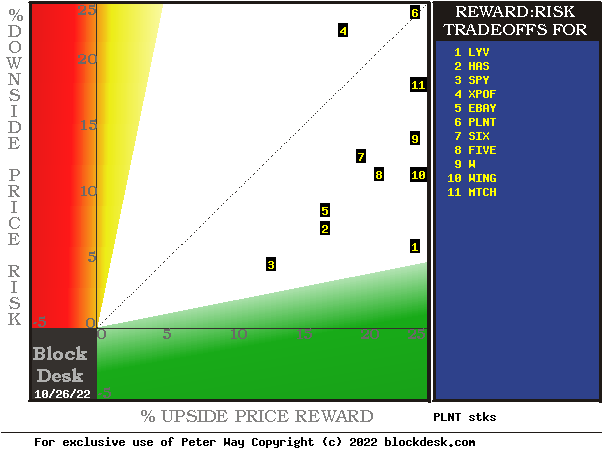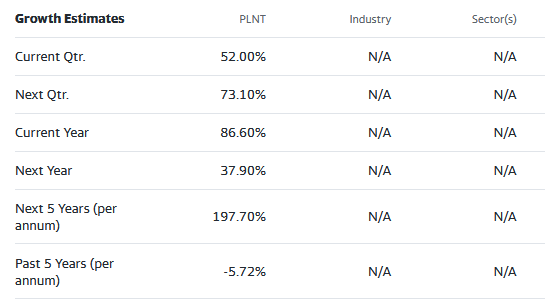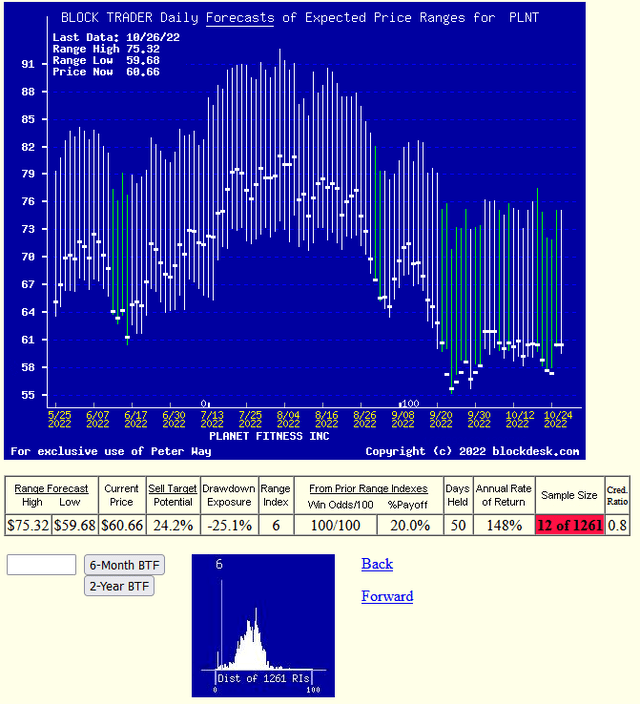Pgiam/iStock via Getty Images
This article’s focus is on earning capital gains from a stock investment in Planet Fitness Inc. (NYSE:PLNT)
Investment Thesis
Knowing when and which stocks to own, actively and selectively, provides a continuing series of net capital gain opportunities delivering wealth accumulation or spendable income at rates which are multiples of what market-index ETFs offer.
If this sounds familiar, it should, because it is our most-used strategy. We know that serious investors want key information to be readily accessible in regular presentations which save their time by knowing where in the report they will find what they want.
You can know what winning institutions know about capital-building stock situations by listening to what the markets tell as capital is being invested. Because today’s markets pay active investors for being in the right places at the right times. They feed off the indolence of passive-strategy investing buy and holders who frequently pass-up timely points of profitable position liquidation.
Increased information technology, communication capabilities, and rapidly evolving competitive practices make this century’s investing markets far more opportune with pricing activity than what 20th century markets offered — FOMO of a 5% annual dividend.
But an active investment strategy requires reasonably-accurate forecasts of what to expect. Fortunately the conditions creating the “hazards” feared by the buy and holders are what provide the needed forecasts. The markets themselves, in their interactions, define what the best-informed professional practitioners see as coming-price limits. In both directions.
Instead of forecasts by analysts of what may be hoped for as price/earnings targets to be sought, the predictive markets of derivatives define ranges within which prices are reasonably being expected. Ranges warning of currently unmaintainable excesses, and of price depressions unlikely to present buying bargains for long.
But if seeking these is not a suitable practice for your situation, continue to ignore it. We are pleased to have your persistent support, rather than competition which might erode our wealth-building productivity.
Risk and reward balances among personal convenience developers
Let’s consider selections from at an “Opportunity Set” of comparable companies ranging from most to least attractive to examine among the many consumer guides active in today’s markets.
Figure 1
blockdesk.com
(used with permission)
Their actions are essential to the conduct of irregular large-volume “block trades” which are the frequent movers of stock prices, rather than the continual small-volume traffic of the “investing public” individuals. Upside price rewards are from their potential reward forecasts, measured by the green horizontal scale.
The risk dimension is of actual price drawdowns at their most extreme point while being held in previous pursuit of upside rewards similar to the ones currently being seen. They are measured on the red vertical scale.
Both scales are of percent change from zero to 25%. Any stock or ETF whose present risk exposure exceeds its reward prospect will be above the dotted diagonal line. Capital-gain attractive to-buy issues are in the directions down and to the right.
Our principal interest is in PLNT at location [6], high on the left-hand vertical red risk scale and on the green horizontal % payoff scale. A “market index” norm of reward~risk tradeoffs is offered by SPY at [3] along with ABBV. Most appealing by this Figure 1 view is LYV.
Description of subject company
“Planet Fitness, Inc., together with its subsidiaries, franchises and operates fitness centers under the Planet Fitness brand. It operates through Franchise, Corporate-Owned Stores, and Equipment segments. The Franchise segment is involved in franchising business in the United States, Puerto Rico, Canada, Panama, Mexico, and Australia. The Corporate-Owned Stores segment operates corporate-owned stores in the United States and Canada. The Equipment segment engages in the sale of fitness equipment to franchisee-owned stores in the United States and Canada. As of December 31,2021, the company had 2,254 stores in 50 states, the District of Columbia, Puerto Rico, Canada, Panama, Mexico, and Australia. Planet Fitness, Inc. was founded in 1992 and is headquartered in Hampton, New Hampshire.”
Source: Yahoo Finance
Yahoo Finance
These growth estimates have been made by and are collected from Wall Street analysts to suggest what conventional methodology currently produces. The typical variations across forecast horizons of different time periods illustrate the difficulty of making value comparisons when the forecast horizon is not clearly defined.
The Figure 1 map provides a good visual comparison of the two most important aspects of every equity investment in the short term. There are other aspects of comparison which this map sometimes does not communicate well, particularly when general market perspectives like those of SPY are involved. Where questions of “how likely’ are present other comparative tables, like Figure 2, may be useful.
Figure 2
(used with permission)
Why do all this math?
Figure 2’s purpose is to attempt universally comparable answers, stock by stock, of a) How BIG the prospective price gain payoff may be, b) how LIKELY the payoff will be a profitable experience, c) how SOON it may happen, and d) what price draw-down RISK may be encountered during its holding period.
Readers familiar with our analysis methods after quick examination of Figure 2 may wish to skip to the next section viewing price range forecast trends for PLNT.
Column headers for Figure 2 define investment-choice preference elements for each row stock whose symbol appears at the left in column [A]. The elements are derived or calculated separately for each stock, based on the specifics of its situation and current-day MM price-range forecasts. Data in red numerals are negative, usually undesirable to “long” holding positions. Table cells with yellow fills are of data for the stocks of principal interest and of all issues at the ranking column, [R].
The price-range forecast limits of columns [B] and [C] get defined by MM hedging actions to protect firm capital required to be put at risk of price changes from volume trade orders placed by big-$ “institutional” clients.
[E] measures potential upside risks for MM short positions created to fill such orders, and reward potentials for the buy-side positions so created. Prior forecasts like the present provide a history of relevant price draw-down risks for buyers. The most severe ones actually encountered are in [F], during holding periods in effort to reach [E] gains. Those are where buyers are emotionally most likely to accept losses.
The Range Index [G] tells where today’s price lies relative to the MM community’s forecast of upper and lower limits of coming prices. Its numeric is the percentage proportion of the full low to high forecast seen below the current market price.
[H] tells what proportion of the [L] sample of prior like-balance forecasts have earned gains by either having price reach its [B] target or be above its [D] entry cost at the end of a 3-month max-patience holding period limit. [ I ] gives the net gains-losses of those [L] experiences.
What makes PLNT most attractive in the group at this point in time is its ability to produce earnings most consistently at its present operating balance between share price risk and reward, the Range Index [G]. Credibility of the [E] upside prospect as evidenced in the [I] payoff is shown in [N]. While occasional large price drawdowns have occurred during holding periods on the way to payoffs, none of those resulted in any closeout losses and average gains have been substantially larger than comparable stocks.
Further Reward~Risk tradeoffs involve using the [H] odds for gains with the 100 – H loss odds as weights for N-conditioned [E] and for [F], for a combined-return score [Q]. The typical position holding period [J] on [Q] provides a figure of merit [fom] ranking measure [R] useful in portfolio position preferencing. Figure 2 is row-ranked on [R] among alternative candidate securities, with PLNT in top rank.
Along with the candidate-specific stocks these selection considerations are provided for the averages of some 3200 stocks for which MM price-range forecasts are available today, and 20 of the best-ranked (by fom) of those forecasts, as well as the forecast for S&P500 Index ETF (SPY) as an equity-market proxy.
As shown in column [T] of figure 2, those levels vary significantly between stocks. What matters is the net gain between investment gains and losses actually achieved following the forecasts, shown in column [I]. The Win Odds of [H] tells what proportion of the Sample RIs of each stock were profitable. Odds below 80% often have proven to lack reliability.
Recent Forecast Trends of Primary Subject PLNT
Figure 3
(used with permission)
Many investors confuse any picture of time-repeating stock prices with typical “technical analysis charts” of past stock price history. Instead, Figure 3’s vertical lines are a daily-updated visual record of price range forecast limits expected in the coming few weeks and months. The heavy dot in each vertical is the stock’s closing price on the day the forecast was made.
That market price point makes an explicit definition of the price reward and risk exposure expectations which were held by market participants at the time, with a visual display of the vertical balance between risk and reward.
The measure of that balance is the Range Index (RI). Here in PLNT, ONLY 6% of the full forecast range of $75 to $60 lies between the current price of $61 and $59.68. With today’s RI there is many times as much upside price change in prospect as downside. All of prior forecasts like today’s RI balance have been profitable, although some were less than at sell targets when closed out due to the maximum investment of time which had been made. The net of that has been to reduce expected potentials of +24% upsides to net accomplishments of +19.5% gains in 50 market days, or about 2 ½ months. So history’s advantage could be repeated 4 – 5 times a year, which compounds with PLNT into a CAGR of +148%.
Conclusion
Based on direct comparisons with PLNT and other advisors of how to spend available personal time, there are several clear reasons to prefer a capital-gain seeking buy in Planet Fitness Inc.




Be the first to comment